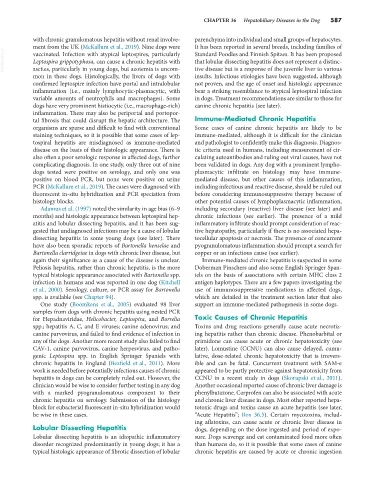Page 615 - Small Animal Internal Medicine, 6th Edition
P. 615
CHAPTER 36 Hepatobiliary Diseases in the Dog 587
with chronic granulomatous hepatitis without renal involve- parenchyma into individual and small groups of hepatocytes.
ment from the UK (McKallum et al., 2019). Nine dogs were It has been reported in several breeds, including families of
VetBooks.ir vaccinated. Infection with atypical leptospires, particularly Standard Poodles and Finnish Spitzes. It has been proposed
that lobular dissecting hepatitis does not represent a distinc-
Leptospira grippotyphosa, can cause a chronic hepatitis with
ascites, particularly in young dogs, but azotemia is uncom-
insults. Infectious etiologies have been suggested, although
mon in these dogs. Histologically, the livers of dogs with tive disease but is a response of the juvenile liver to various
confirmed leptospire infection have portal and intralobular not proven, and the age of onset and histologic appearance
inflammation (i.e., mainly lymphocytic-plasmacytic, with bear a striking resemblance to atypical leptospiral infection
variable amounts of neutrophils and macrophages). Some in dogs. Treatment recommendations are similar to those for
dogs have very prominent histiocytic (i.e., macrophage-rich) canine chronic hepatitis (see later).
inflammation. There may also be periportal and portopor-
tal fibrosis that could disrupt the hepatic architecture. The Immune-Mediated Chronic Hepatitis
organisms are sparse and difficult to find with conventional Some cases of canine chronic hepatitis are likely to be
staining techniques, so it is possible that some cases of lep- immune-mediated, although it is difficult for the clinician
tospiral hepatitis are misdiagnosed as immune-mediated and pathologist to confidently make this diagnosis. Diagnos-
disease on the basis of their histologic appearance. There is tic criteria used in humans, including measurement of cir-
also often a poor serologic response in affected dogs, further culating autoantibodies and ruling out viral causes, have not
complicating diagnosis. In one study, only three out of nine been validated in dogs. Any dog with a prominent lympho-
dogs tested were positive on serology, and only one was plasmacytic infiltrate on histology may have immune-
positive on blood PCR, but none were positive on urine mediated disease, but other causes of this inflammation,
PCR (McKallum et al., 2019). The cases were diagnosed with including infectious and reactive disease, should be ruled out
fluorescent in-situ hybridization and PCR speciation from before considering immunosuppressive therapy because of
histology blocks. other potential causes of lymphoplasmacytic inflammation,
Adamus et al. (1997) noted the similarity in age bias (6–9 including secondary (reactive) liver disease (see later) and
months) and histologic appearance between leptospiral hep- chronic infections (see earlier). The presence of a mild
atitis and lobular dissecting hepatitis, and it has been sug- inflammatory infiltrate should prompt consideration of reac-
gested that undiagnosed infections may be a cause of lobular tive hepatopathy, particularly if there is no associated hepa-
dissecting hepatitis in some young dogs (see later). There tocellular apoptosis or necrosis. The presence of concurrent
have also been sporadic reports of Bartonella henselae and pyogranulomatous inflammation should prompt a search for
Bartonella clarridgeiae in dogs with chronic liver disease, but copper or an infectious cause (see earlier).
again their significance as a cause of the disease is unclear. Immune-mediated chronic hepatitis is suspected in some
Peliosis hepatitis, rather than chronic hepatitis, is the more Doberman Pinschers and also some English Springer Span-
typical histologic appearance associated with Bartonella spp. iels on the basis of associations with certain MHC class 2
infection in humans and was reported in one dog (Kitchell antigen haplotypes. There are a few papers investigating the
et al., 2000). Serology, culture, or PCR assay for Bartonella use of immunosuppressive medications in affected dogs,
spp. is available (see Chapter 94). which are detailed in the treatment section later that also
One study (Boomkens et al., 2005) evaluated 98 liver support an immune-mediated pathogenesis in some dogs.
samples from dogs with chronic hepatitis using nested PCR
for Hepadnaviridae, Helicobacter, Leptospira, and Borrelia Toxic Causes of Chronic Hepatitis
spp.; hepatitis A, C, and E viruses; canine adenovirus; and Toxins and drug reactions generally cause acute necrotiz-
canine parvovirus, and failed to find evidence of infection in ing hepatitis rather than chronic disease. Phenobarbital or
any of the dogs. Another more recent study also failed to find primidone can cause acute or chronic hepatotoxicity (see
CAV-1, canine parvovirus, canine herpesvirus, and patho- later). Lomustine (CCNU) can also cause delayed, cumu-
genic Leptospira spp. in English Springer Spaniels with lative, dose-related chronic hepatotoxicity that is irrevers-
chronic hepatitis in England (Bexfield et al., 2011). More ible and can be fatal. Concurrent treatment with SAM-e
work is needed before potentially infectious causes of chronic appeared to be partly protective against hepatotoxicity from
hepatitis in dogs can be completely ruled out. However, the CCNU in a recent study in dogs (Skorupski et al., 2011).
clinician would be wise to consider further testing in any dog Another occasional reported cause of chronic liver damage is
with a marked pyogranulomatous component to their phenylbutazone. Carprofen can also be associated with acute
chronic hepatitis on serology. Submission of the histology and chronic liver disease in dogs. Most other reported hepa-
block for eubacterial fluorescent in-situ hybridization would totoxic drugs and toxins cause an acute hepatitis (see later,
be wise in these cases. “Acute Hepatitis”; Box 36.5). Certain mycotoxins, includ-
ing aflatoxins, can cause acute or chronic liver disease in
Lobular Dissecting Hepatitis dogs, depending on the dose ingested and period of expo-
Lobular dissecting hepatitis is an idiopathic inflammatory sure. Dogs scavenge and eat contaminated food more often
disorder recognized predominantly in young dogs; it has a than humans do, so it is possible that some cases of canine
typical histologic appearance of fibrotic dissection of lobular chronic hepatitis are caused by acute or chronic ingestion

